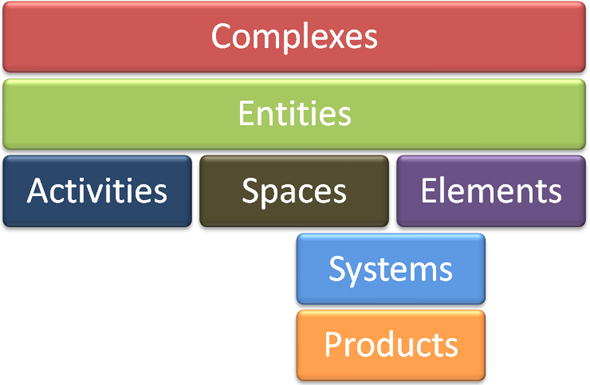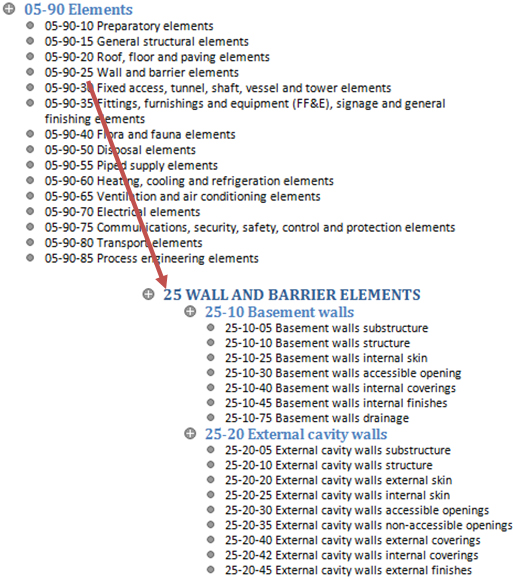To understand Uniclass2 let's start by considering what a classification system is. One of the simplest and most effective classification systems in use today is the system adopted by the dictionary. A dictionary organises information in a standardised manner and this has many benefits including:
- Information can be found and retrieved very easily
- The dictionary rules (its taxonomy) are easy to understand and apply. Information can be added to a dictionary following these rules to ensure it appears in the correct place
- There is no limit to the information that the dictionary can accommodate
- Information can be referenced
- Information is maintained.
These benefits underpin the purpose of all classification systems. The amount of construction information that is produced is vast and given the many parties involved in creating and maintaining a building's information it is perfectly sensible to organise and classify this content. Classifying enables construction information to be organised, easily accessed, improved and shared. Building Information Modelling (BIM) needs structured information and a good classification is essential to this. Uniclass2 provides a structured approach to classifying the building information by organising information based upon common characteristics. Uniclass2 extends beyond buildings to all aspects of the built environment.
Uniclass2 groups like information in tables and these tables can be viewed in a hierarchy of increasing detail as shown in Figure 1, where complexes comprise entities, entities comprise elements, elements comprise systems, and systems comprise products. It also provides tables that can be used to classify activities and spaces. Buildings comprise spaces, and activities take place in these spaces.

Figure 1 - Uniclass2, viewed as a hierarchical classification for built asset information
So taking Uniclass2 at its broadest level, a complex such as a hospital will comprise many entities, e.g. buildings, roads and landscape. These entities can individually comprise elements which themselves comprise systems and so on. This cascade of increasing detail supports the creation and development of the built environment. At early stages, a client brief will require particular activities, and through design development this leads to the formation of spaces and these spaces will be defined by various elements. Performance requirements attributed to spaces and elements are necessary to make the spaces useful. System choice and product selection then follow and are necessary to form the space and enable its use.
Uniclass2 is the new UK implementation of the international framework for construction information defined by the revised version of ISO 12006-2, and the tables in Uniclass2 are based on this standard:
| Table Reference | Title |
|---|---|
| Co | Complexes |
| En | Entities |
| Ac | Activities |
| Sp | Spaces |
| Ee | Elements |
| Ss | Systems |
| Pr | Products |
| WR | Work results |
Figure 2 - Uniclass2 tables for construction information
Each table has groups of similar information and follows a hierarchy that expands with increasing levels of detail from a two digit code to six digits. For example, in the Administrative and Commercial group of the entities table Commercial Administrative Buildings are classified as 25-50 with small single office buildings having a lower level classification of 25-50-70. This principle of increasing specialisation applies to all tables as can be observed from this example from the Product table: Openings are classified by group 60 of the Product table, Windows are a sub-group as classified by 60-98 with Hardwood Windows being 60-98-36.
And now for the really clever bit. Unlike its predecessor, Uniclass, Uniclass2 is unified, i.e. the tables relate and correspond to one another. This makes Uniclass2 significantly more suitable for BIM than original Uniclass. Mapping is done outside of Uniclass2 but is only possible because of the Uniclass2 tables. The unified nature of Uniclass2 means that just a single table (the Work results table) can be used to cover the entire project timeline. It includes civil and process engineering too so it can be used on multi-disciplinary projects. Connections between the Work results table and other Uniclass2 tables become evident when the codes are examined. For example, a selection of elements from the work results table is shown below alongside an extract from the Uniclass2 Elements table. The important aspect to observe is that the last 2 digits of each work results code directly correspond to the Uniclass2 elements, i.e. the 25 in the code of work results section 05-90-25 Wall and barrier elements relates directly to the 25 group of elements in the Elements table. This unified approach is very powerful as it connects related information together.

Figure 3 - Extract from Work Results table - the Element grouping (top) and an extract from the Elements table - the wall and barrier elements(bottom)
For the very first time the UK has a unified classification that can structure how information about a built asset can be accessed, developed and maintained which in turn will lead to easier collaboration, improved understanding and greater efficiency through smarter technologies that interoperate. Uniclass2 has been a long time in the making but now it's here it's hard to imagine building information without it.
To finish off here are some answers to a few common Uniclass2 questions...
Who is behind Uniclass2?
Uniclass2 has been created by Construction Project Information, a group representing all facets of the built environment. The group comprises:
- The Royal Institute of British Architects (RIBA)
- The Royal Institution of Chartered Surveyors (RICS)
- The UK Contractor's Group (UKCG)
- The Institute of Civil Engineers (ICE)
- The Chartered Institution of Building Services Engineers (CIBSE)
- The Chartered Institute of Architectural Technologists (CIAT)
- The Chartered Institute of Building (CIOB).
What stage is Uniclass2 at?
Uniclass2 is currently available for public consultation. Proposals are available to review on the CPI website (http://www.cpic.org.uk/uniclass/ ![]() ). It is expected that Uniclass2 will be searchable online in February 2013.
). It is expected that Uniclass2 will be searchable online in February 2013.
Why change from Uniclass to Uniclass2?
The original Uniclass tables do not cover building, infrastructure and process engineering consistently and they do not work well together. Improvements are needed to allow information to mature in detail, progressively using the appropriate tables at the relevant time. A logical and consistent numbering system across all tables is needed so that information is both human and software readable.
Uniclass2 is the open classification system for BIM, and it will be freely available for use by all throughout the life cycle of a project and beyond. Furthermore it will be available online in various formats and be managed and updated.
What will happen to CAWS?
The Common Arrangement of Work Sections (CAWS) is table J of original Uniclass. Uniclass2 includes an equivalent table but this table has been unified with the other Uniclass2 tables. The new Uniclass2 Work results table will replace CAWS.
How can Uniclass2 map to other classifications?
The important aspect of any classification is that it is used consistently and when used in this way content in one classification can be mapped to another. Projects such as the buildingSMART Data Dictionary and www.bimgateway.com ![]() are demonstrating how, through the use of structured machine readable information, mapping between classifications is possible.
are demonstrating how, through the use of structured machine readable information, mapping between classifications is possible.
How does Uniclass2 relate to COBie?
Many of the tables in a COBie spreadsheet require a classification so that the data can quickly be filtered and compared. For construction projects to UK standards and practice, Uniclass2 offers classification for Construction Entities, Spaces, Systems and Products. Within the COBie-UK-2012 specification the Category field in the tables Facility, Space, System and Type may be populated by the corresponding Uniclass2 code.
Further information
The Uniclass2 classification can be viewed for comment on the CPI website: www.cpic.org.uk/uniclass/ ![]()
Ian Chapman can be contacted via:
- Twitter: @ianchapmannbs
- LinkedIn: www.linkedin.com/in/ianchapmannbs.

